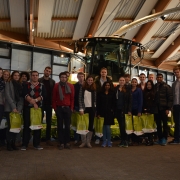Excursion and Factory Visit at the CLAAS-Group

How many combine harvesters are needed to harvest the corn that is required for the production of all 6.4 billion bread rolls that wind up on the German consumer’s plates? Not more than 28, at least if LEXION 780 combines, that originate from the production of the agricultural machinery manufacturer CLAAS, are used. The family company that has representatives in 140 countries focuses on technology leadership in agricultural engineering: At CLAAS, latest technological developments such as machine-to-machine communication and intelligent networking are not just keywords but already built in the available products. This technology helps to make the whole harvesting process more efficient, so that soon even more corn for much more rolls will be harvested - while less farm equipment is needed, of course.
The company itself gives a good example for up-to-date businesses and intelligently designed supply chains. That’s why the Chair for Information Systems and Supply Chain Management together with a group of students undertook an excursion to the main factory of CLAAS in Harsewinkel. The group was given a tour of the plant by Mr. Norbert Diekhans who provided insights into the ongoing production. During lunch break the students made use of the opportunity of talking to CLAAS representatives. As the students theoretical knowledge from the lectures „Supply Chain Management“ and „Operations Management“ was supplemented by practical experience, the presentation of The Head of SCM, Mr. Dietmar Düsing, attracted the visitors’ interest in particular. Further on, the students experienced the relevance of the chair’s research: For example, how intelligent maintenance systems help to estimate the spare parts demands – and how important that is for a company such as CLAAS.
The excursion was complemented by a presentation on career opportunities at CLAAS, a company that looks back on a history of more than 100 years. How to become one of the 11.000 employees? Ms. Janina Ostendorf and Ms. Sarah Strathmann gave a broad overview of the numerous entry-level options: Starting to work while completing the degree, via a trainee program, direct employment, as an intern, in Germany or at one of the international offices.

